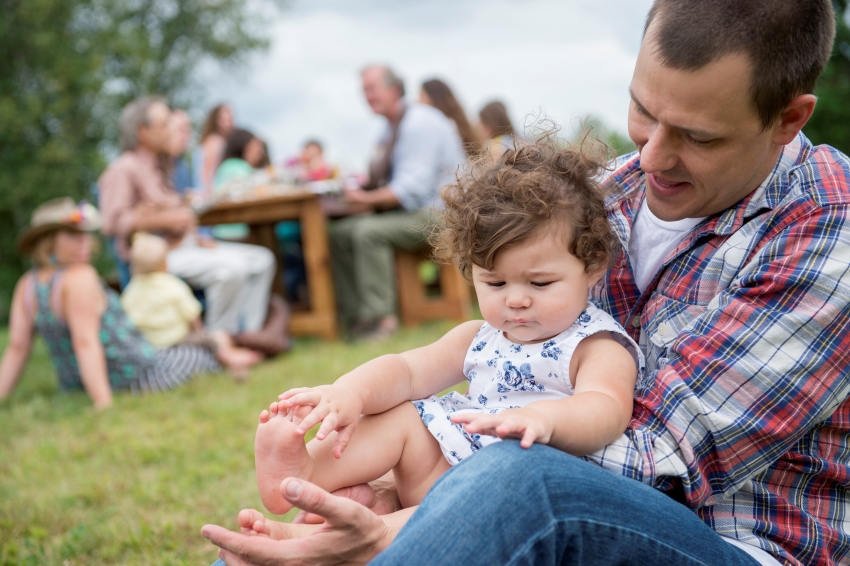Key takeaways for caregivers
- The messages caregivers convey in their conversations with preschool-aged children about science can affect children’s understanding of the roles of intelligence and effort in scientific learning.
- Experimental evidence shows that children persist longer on a challenging task after reading scientific storybooks that emphasize the role of effort and hard work in science rather than books that focus only on success and achievements.
- Children who read a storybook with their caregiver about a famous scientist who experienced many challenges along the path to success were more likely to believe that people can become smarter over time and to view hard work as the key to success in science, technology, engineering, and math (STEM) fields.
Emphasizing hard work and effort in everyday activities at home
“I want to build a really big tower,” says four-year-old Marlee as she stands beside a pile of blocks on the floor at home.
“Let’s try a few blocks and see what happens,” suggests her mother.
“One, two, three, four, five. This is hard!” says Marlee as she starts building her tower. After adding the fourth and fifth blocks, the entire tower collapses and Marlee flops down on the floor.
“Sometimes things don’t quite work at first, but we shouldn’t give up,” says Marlee’s mother. “When I first learned how to cook, I tried to make chicken. Do you know what happened? I left it in the oven too long and the entire chicken burned. Did I let that stop me from learning how to cook? No. I kept trying. Even when something is hard at first, we still have to keep trying to learn something new. Now, let’s try again.”
This vignette of a mother and daughter highlights the opportunities for young children to learn how hard work, failure, and persistence play a critical role when engaging in a challenging task, especially in the science domain.
Simple activities such as building a tower, cooking, or reading scientific storybooks together engage children in meaningful STEM experiences during early childhood years (ages three to six years).
Interactions with adults during these activities can also influence children’s beliefs about themselves as learners, their interest in science throughout their schooling, and their later sense of belonging in STEM careers.
Caregiver-child talk during daily STEM-related activities
During daily interactions, caregivers and teachers often talk with young children about scientific and mathematical concepts. Adults’ language can influence children’s beliefs about themselves as learners and their beliefs about who can be engaged in science.
However, adult language in such conversations may differ by gender. For example, during the toddler years, caregivers talk more to boys than to girls about math concepts, and during early and middle childhood, caregivers are more likely to provide scientific explanations to boys than to girls.
Adults’ language can influence children’s beliefs about themselves as learners and their beliefs about who can be engaged in science.
These different patterns in parents’ talk with boys and girls can result in differences in how children respond to opportunities to engage in STEM activities. For instance, when children engaged in a science activity are told they are “doing science” versus “being scientists,” only four-year-old girls (not boys) persisted longer at the task. In addition, six-year-old girls (not boys) preferred a game for children who “work really hard” (highlighting effort) over a game for children who are “really smart”.
Reading stories about scientists
In addition to adult-child conversations, research suggests that hearing a story about a famous scientist’s challenges on the path to achieving success (rather than focusing on success with no mention of failure) can lead to higher levels of persistence and achievement in science tasks for young students as well as high schoolers.
For example, in one of our studies, four- and five-year-olds read a book with an experimenter about a scientist (Albert Einstein or Marie Curie) who achieved success. The stories either described the challenges the scientist struggled with along the way or told only of their ultimate success.

Photo by Kindel Media on Pexels
After the reading, we gave children an impossible task: to try to find differences between two identical pictures. Children who heard about a scientist who faced challenges on the path to success persisted longer on the task than did children who heard only about a scientist’s success.
Exploring the impact of caregiver-child talk during a storybook reading about scientists
In our recent follow-up study, we combined this investigation of the effects of storybook content with an exploration of caregiver-child talk, given the potential for these influences to jointly affect children during a storybook reading session.
We were particularly interested in how caregiver-child talk while reading a scientific storybook might affect children’s mindset beliefs—that is, their beliefs about whether intelligence is something that can change over time (endorsing more of a growth mindset) or something that remains relatively the same (endorsing more of a fixed mindset).
Curie and Johnson are from groups that are often underrepresented in STEM fields and in drawing on their stories, we aimed to diversify for young children the image of who can be a scientist.
Findings from past work suggests that who endorse more of a growth mindset perform better in science and math classes than those who do not endorse this mindset, but we know little about how the growth mindset relates to STEM performance in younger children.
Similarly, past research has focused on stories of White male scientists. In our study, we focused on the personal narratives of White and Black female role models in STEM: Marie Curie and Katherine Johnson. Curie and Johnson are from groups that are often underrepresented in STEM fields and in drawing on their stories, we aimed to diversify for young children the image of who can be a scientist.
Our research
My colleagues (Sona Kumar, Kathryn Leech, and Kathleen Corriveau) and I sought to determine how caregiver-child talk while reading a scientific storybook on the achievements or struggles of White or Black female scientists might affect preschoolers’ beliefs about themselves as learners (mindset beliefs). We also sought to learn how such talk affected children’s understanding of the relation between effort and success in STEM endeavors and their persistence during a challenging task.
Our study, conducted in the United States, included 202 children (ages four to five years), nearly half of whom were girls. Each student completed the study with their caregiver, most of whom were female. Approximately 60% of families were White, 17% were of mixed race, 11% were Asian, and 11.5% or fewer identified as Hispanic, Black, Southern Asian or Indian or did not report their ethnicity. Roughly 92% of caregivers had at least a four-year-college degree and almost 65% of families had an annual income greater than $100,000.
The four parts of our research
Children and their caregivers participated in one online Zoom session that included four parts:
- Scientific storybook reading (caregivers and children): Families were randomly assigned to read a researcher-developed, eight-page book about a female scientist (Marie Curie or Katherine Johnson) who either achieved success without any failure (achievement book) or struggled along the path to achieving success (effort book).
- Question about children’s beliefs about intelligence (children only): After the reading, an experimenter asked the children a question aimed at understanding their beliefs about intelligence as something that remains the same (fixed mindset) or something that can change (growth mindset).
- Persistence task (children only): Children were presented with a challenging task that included two identical pictures of electronic circuits built from modular pieces from a children’s science kit. They were then asked to find the difference between the pictures. We measured persistence as the number of seconds children spent looking for differences between the pictures before declaring they were done.
- Question about the role of brilliance versus effort in STEM success (children only): The experimenter asked each child a question to see whether they viewed effort or brilliance as the key to success in STEM: “The scientist won an award for a new invention. Do you think the scientist is smart or hard-working?” Children were invited to choose as their answer “smart” or “hard-working.”
Our research questions
By randomly assigning families to one of two experimental storybook conditions (achievement, effort), we were able to answer the following research questions:
- What type of talk do families engage in while reading a storybook and how does this differ based on the content they are assigned to read (assigned storybook condition)?
- How does the storybook condition affect children’s beliefs about intelligence, persistence on a challenging task, and understanding of the role of effort in people’s success in STEM?

Photo by RDNE Stock project on Pexels
We were particularly interested in understanding what type of storybook language most frequently fostered effort talk, growth mindset, beliefs in the role of effort in success, and persistence during a challenging task.
Exploring research question 1: Caregiver-child talk during scientific storybook reading reflects the topics emphasized in the storybook’s text
Did all the families produce every type of talk? In short, no. Families in the achievement storybook condition talked more about brilliance, while families in the effort storybook condition talked more about effort, connections, and emotion.
Our findings suggest that caregivers built on the language in their assigned storybook when talking with their children. For example, the language in the effort storybook condition encouraged families to talk more about the process of doing science and created more opportunities for children to make connections to the scientist in the story.
Exploring research question 2: Caregiver-child storybook reading focusing on effort supports children’s adoption of beliefs and behavior that also emphasize effort

Photo by Photo By: Kaboompics.com on Pexels
Compared to children in the achievement storybook condition, children in the effort storybook condition:
- Were more likely to indicate that intelligence can grow (i.e., a growth mindset),
- Persisted longer on the challenging STEM task, and
- Were more likely to attribute the scientist’s success to effort than to intelligence.
Conclusion
Overall, our findings indicate that during the preschool years, the messages emphasized during shared scientific storybook reading may affect young children’s beliefs about themselves as learners and their understanding of the process of doing science.
Storybook content and caregiver-child conversation during readings can be designed to emphasize messages of learning, effort, and persistence on scientific tasks. Such interventions can facilitate children’s sense of belonging in STEM fields before they start K-12 schooling.
The post How reading scientific storybooks and related conversations with children affect children’s persistence appeared first on Child and Family Blog.











